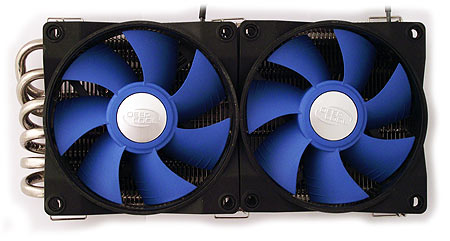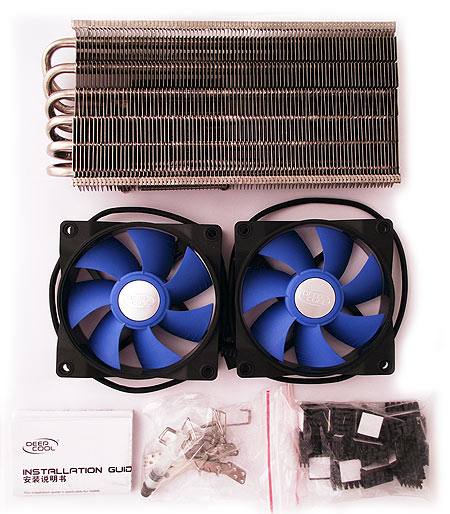Three Aftermarket Graphics Coolers On GeForce GTX 480
Today we're testing three of the largest graphics card coolers available: Arctic Cooling's Accelero XTREME Plus, DeepCool's V6000, and Zalman's VF3000F. Can these products bring performance to the table commensurate with their large triple-slot size?
DeepCool V6000
I’m going to preface this by letting you that nobody is selling this cooler in the US right now. We were promised that the V6000 would be for sale in North America through moddersmart.com when we agreed to include the product in our roundup, but it isn’t available there yet. The DeepCool representative says the cooler launched last month and the company is in talks with distributors. The suggested MSRP is $60.
The DeepCool V6000 is a generic graphics card cooler that will work on a long list of graphics cards, including the Radeon HD 5800- and GeForce GTX 400-series boards.
The V6000 is another large model, weighing in at 759 grams (~1 lb. 6.6 oz.) The cooler is 65 mm wide by 110.5 mm tall by 212.5 mm long. While it has the shortest length of the coolers in our roundup, it is the widest.
This cooler features six heatpipes attached to a cooling block and fins, all made of aluminum. Two 92 mm case fans are used to create an advertised 66 CFM of airflow. The fans are held to the cooler by wire retainers, and they do a good job of securing them.
The downside to using standard case fans is that this cooler requires a pair of three-pin fan headers on the motherboard. We’re surprised that DeepCool didn’t include a Molex adapter to provide power to the unit, something that would make installation simpler for many users.
The package contains the cooler, an installation guide, the fans, RAM and VRM heatsinks, in addition to a syringe of thermal paste. The first step is to install the fans on the cooler using the mounting hardware.
Assuming the GeForce GTX 480 reference cooler has already been removed, the contact surfaces have to be cleaned and installation can begin. First, the RAM and VRM heatsinks must be applied, and DeepCool’s method of application is thermal tape.
Get Tom's Hardware's best news and in-depth reviews, straight to your inbox.
Thermal tape can be a fine tool, and it allows some flexibility if you want to migrate your cooler to another graphics card later (as it is usually possible to remove thermal tape). Unfortunately, our DeepCool V6000 test sample includes the worst thermal tape I have ever used. It is barely sticky enough to keep the heat sinks attached to the card, and I fear (it turns out rightfully so) that the sinks will fall off when the card is heated under load. I contacted DeepCool and was assured that the problem was reported to the R&D department. Just prior to publishing, I was informed that the thermal tape problem has been solved. This is great news, but unfortunately we don't have a fixed sample on-hand for testing. All we can demonstrate are results from the flawed version.
Assuming the RAM and VRM sinks are attached, thermal paste is applied to the GPU and the V6000 is attached to the graphics card. There are a number of screw holes on the heat sink for different boards, so it's simply a matter of lining up the mounting holes that correspond to the card we're using. Four screws later and the heatsink is in place—we make sure that we don’t forget to attach both cables to fan headers on the motherboard.
As with all of the coolers in our roundup, this graphics card and cooler combo consumes three expansion slots on the motherboard.
Don Woligroski was a former senior hardware editor for Tom's Hardware. He has covered a wide range of PC hardware topics, including CPUs, GPUs, system building, and emerging technologies.
-
AMW1011 Wow, I can't believe the Accelero and the Zalman were basically neck and neck, with no tangible victory in cooling. I always thought the Accelero would be better, but Zalman actually pulled this one off.Reply
However, what would be AMAZING, is to have a follow-up to see which of these two solutions work best in SLI, assuming EITHER work well in SLI. I think that is the big question, especially since we never expected bad temps.
Also can you please add the voltages used for each overclock? It might give people, especially stock GTX 480 owners, a better idea of what these can handle, since cards will always vary when overclocking.
Holy ***, stock voltages! That is crazy! Please post up your VID (stock voltage) for us. Either you have a golden GTX 480, or the VID is a lot higher than it needs to be, which is pretty common.
Great article, I love to see these kind of side articles/reviews, and it was well done. -
Nerdbox87 Given that this entire article is based on cooling you really should have included all GPU temps - as vram / vrm cooling may be the difference between the Accelero and the Zalman (as I know my Accelero Twin Turbo on a 5850 struggled with vram temps in Furmark)Reply
On this my guess would be the Zalman would smash it -
joytech22 How was the 480 at just under 60C when my 470's are always idling at 86C in a Antec twelve hundred..?Reply
I mean sure this case isn't the best cooling case but there's never really much hot air in the case and with a sidepanel fan blowing on the two cards i just cant see how.
Unless.. you guy's test in a cool room at about 15-20C or the fan speeds are maxed 100% of the time. -
dvijaydev46 Oh, Zalman's cooler looks weaker than Accelero but the later actually outperforms a bit. That's amazing.Reply -
Th-z Don, what is your view on how to apply thermal paste. There are numbers of ways people talk about: a pea in the middle, several peas, line in the middle, several lines, and old school spread method. You use spread method when you apply the RAM/VRM sink on Zalman, I presume you use the same method on other parts, too. Maybe Tom can do a comparison test on different ways of applying thermal paste.Reply -
compton These look good and would help me out quite a bit with a 465/470, but I wish I could get them in a design that would help maintain the existing footprint. My GF100 doesn't run quite as hot as some reference card designs, but that sure as hell doesn't mean that I'm happy with the leaf blower lurking in my case. Maybe I find a way to make the Zalman work.Reply -
avatar_raq I think the Zalman one wins here. It performs slightly better, costs slightly less, weighs less and is shorter than the Arctic cooler. As for noise they're trading blows. Being shorter, the VF3000 does not increase the length of the GTX 480, unlike the accelero which may theoretically cause incompatibility with some cases. Being lighter, it strains the PCB much less. The fact it performed so close to the Arctic cooler with only 2 fans surprised me.Reply






